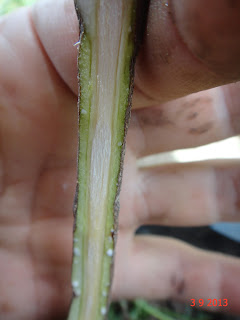Side Veneer Grafting On Jackfruit.
Decided to try out Side Veneer grafting on the Jackfruit. Most of the rootstock is from the failed previous cleft grafting.
Reasons that I trying out side veneer is that
1) it may be easier to align the cambium layer.
2) we may extend the joint to a longer graft.
3) it may be easier to graft on different diameter.
4) it may be easier, less laborious to cut the rootstock and scion.
 |
| Young Jackfruit scion. |
First I cut off the top to about 6 to 10 inches. It's easier to work with.
Then
I prepare the scion. Scion of about 6 to 10 inches is used. I am
targeting a joint of 4 to 6 inches. I cut starting from the tip and
splice it down. Had started to use new growth scion.
 |
| Jackfruit rootstock, side veneer grafting. |
Then I do a side cut by first cutting into the lower section of the rootstock like a side wedge. I go back from the top, do a side cut and stop as soon as I
feel the that I've cut off the soft part, before the hard section. Splice this down until the lower cut.
 |
| Matching the Jackfruit scion to the Jackfruit rootstock. |
The lower tip of the scion is wedge shaped and inserted into the lower cut of the rootstock. I align the scion slightly for cambium contact.
 |
| Wrapping the side veneer Jackfruit graft. |
I start of the wrapping and realign along the way. I try to align as best a I can on one side, but sometimes if it is not straight, I shall cross it to the other side. Am reducing the wrapping pressure due to my previous experience and also in view of the young scion.
 |
| Finished Jackdfruit graft. |
Finishing off with a plastic bag and tie up to prevent it from blowing off. Keeping these in a shaded area, 90% Shade screen.
 |
| Storing my grafted Jackfruit trees. |
Some of the grafted trees.
My grafting position.
 |
| Doing grafting under shade. It's much cooler. |
 |
| Over grown Jackfruit rootstock. |
The over grown roostock.
 |
| Add caption |
 |
| Top deactivated. |
Cutting off the top.
 |
| Jackfruit rootstock. |
 |
| Note the bud. |
 |
| Cap the grafted Jackfruit with a plastic bag to prevent humidity lost. |
A not so straight scion.
 |
| Matching the length. |
 |
| Matching up. |
 |
| My view, under the citrus tree, doing side veneer grafting on Jackfruit. |
Mid day now. Sun is getting pretty hot and almost directly over head. Time to move into the shade.
This time I did 8 trees on the scion taken from the Honey Jackfruit. The 4 new plants that I have. Hope they can grow more buds after this. Just for the fun of it I did 2 for the soursop :-)
Had done all I could before I go on leave. Shall be back end of the month. This time hope I can achieve my 30%. Stay tune.




































